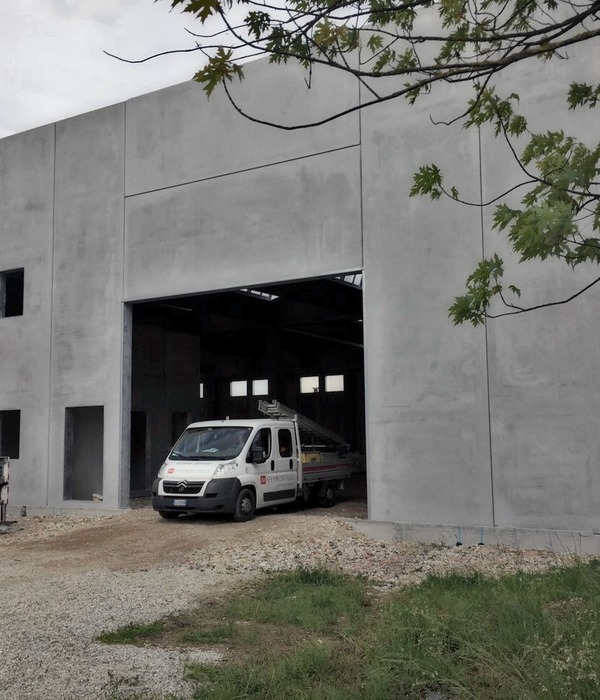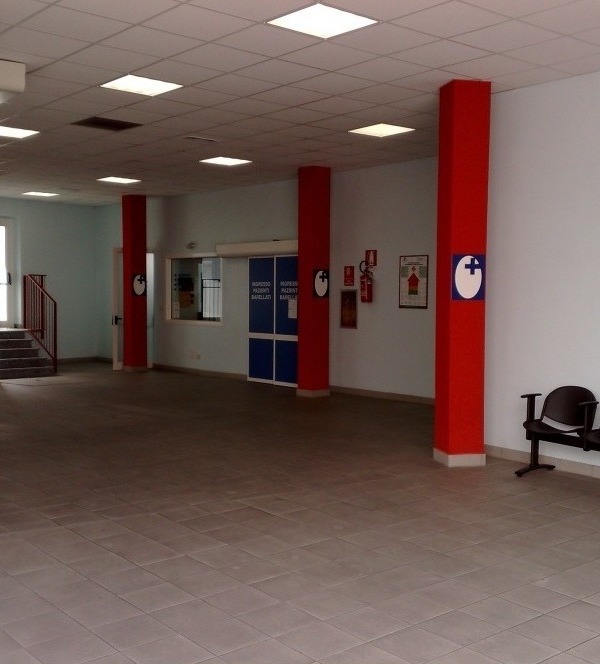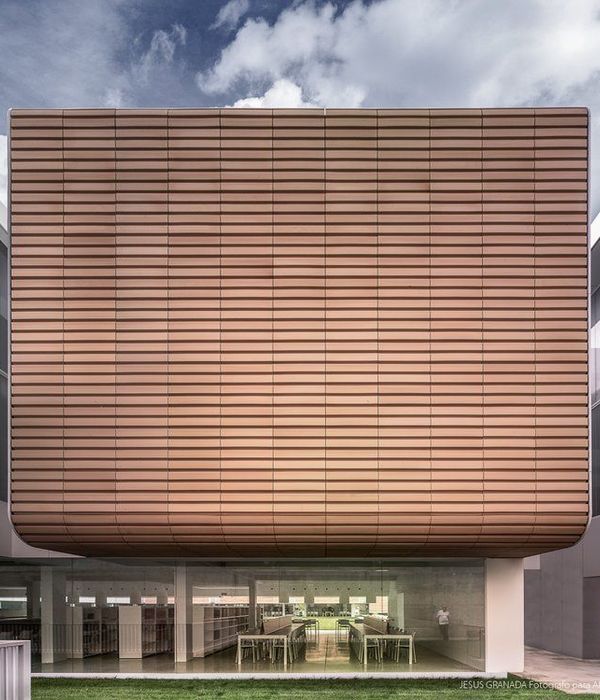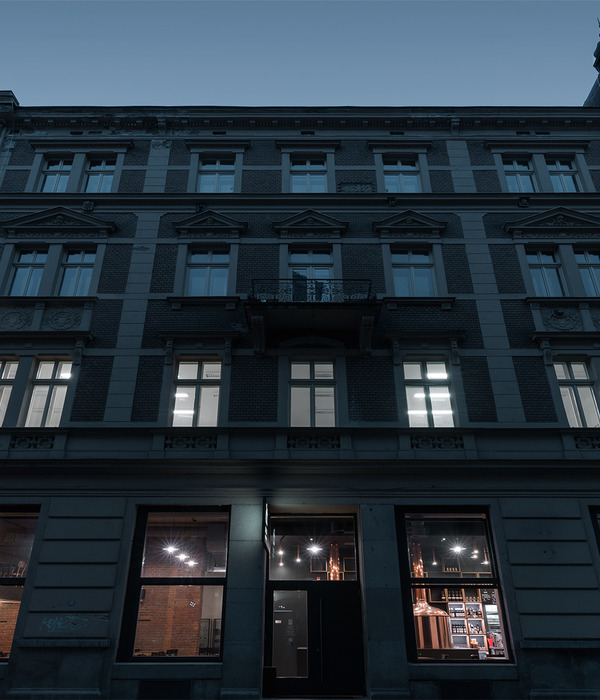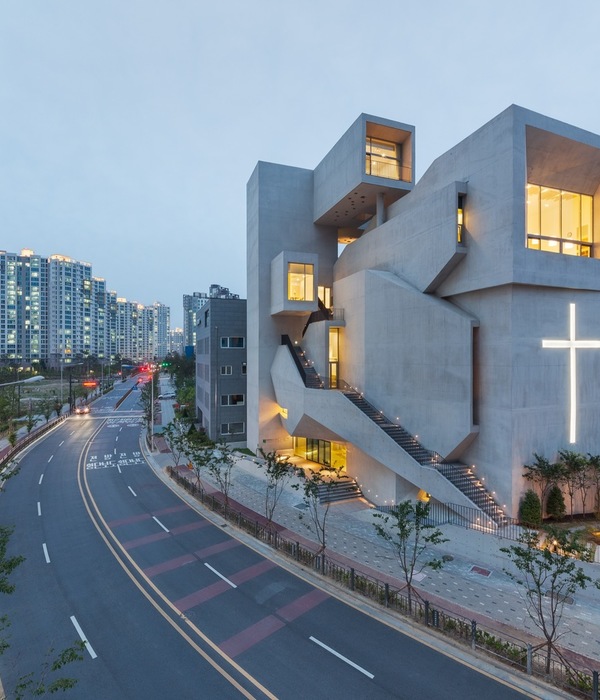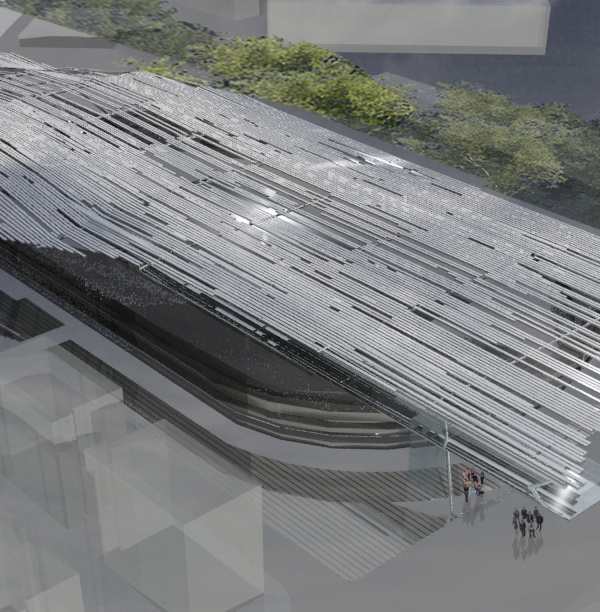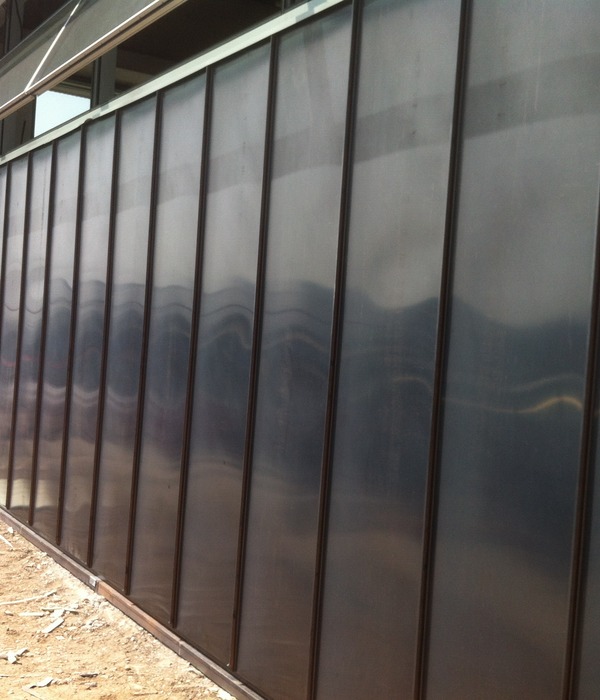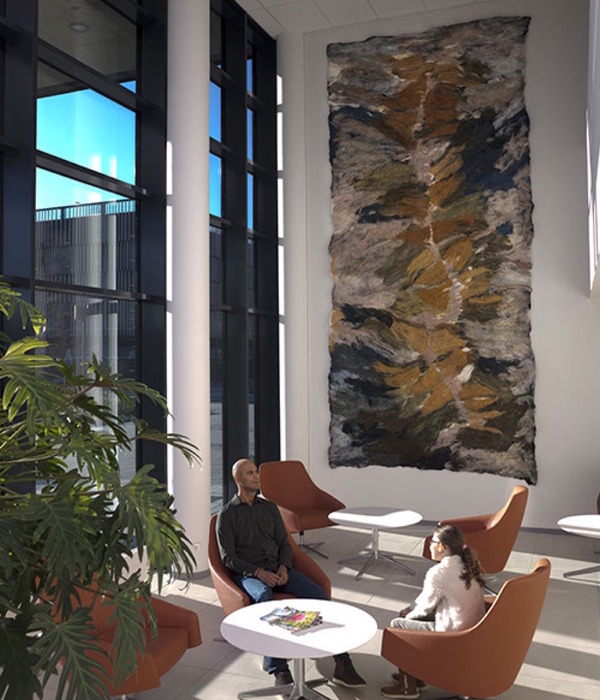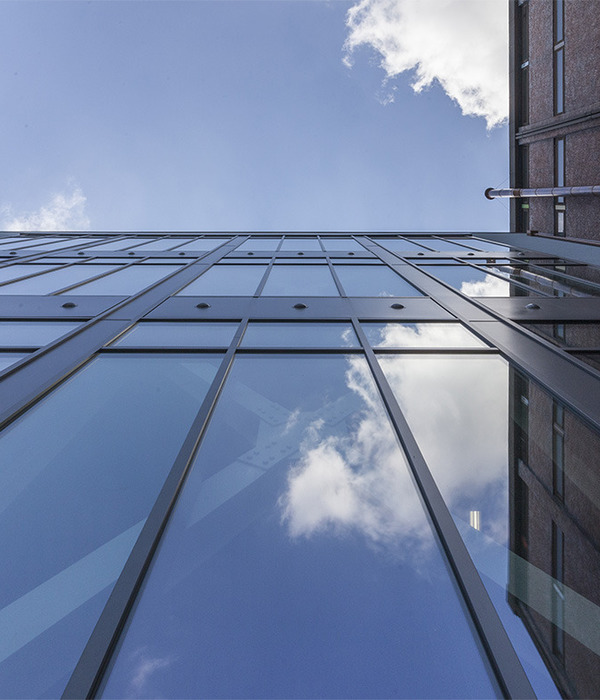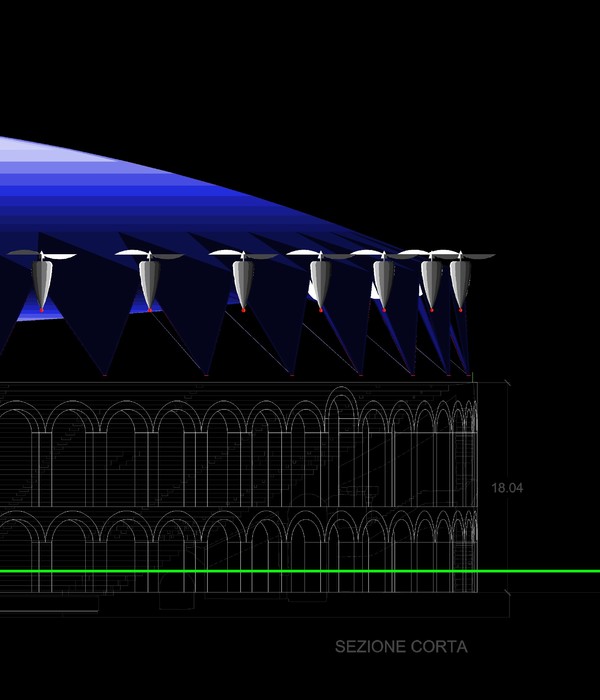这座铁路博物馆凭借其极具雕塑感的接待大楼,成为该地区工业文化古迹中的一部分。在博物馆附近的是波鸿德国矿业博物馆和于2001年被联合国教科文组织列为世界遗产的佐尔夫雷因煤矿工业园。园区内广泛分布的矿山、贮气罐和铁路设施让人不禁回想起采矿和工业历史。新的接待大楼不仅是未来铁路技术的实验室,其醒目的砖塔结构还作为博物馆入口指引着游客的进入。
With its sculptural reception building, the museum is part of the network of industrial-cultural monuments of the region, which, with its mines, gasometers and railway facilities, is reminiscent of the history of mining and industry. In the immediate vicinity of the railway museum are the German Mining Museum Bochum and the Zollverein Coal Mine Industrial Complex, which has been a UNESCO World Heritage Site since 2001. At the same time, the new building sees itself as a laboratory for the future technology railway. As a new landmark, a striking brick tower shows the entrance to the museum.
▼项目外观,exterior view of the project ©Stefan Müller
▼周围遍布着铁轨的博物馆接待大楼,the museum reception building is surrounded by railroad tracks ©Stefan Müller
新的接待区作为博物馆全新概念的一部分,旨在为访客提供更具吸引力的服务和展品呈现。改组后的博物馆也成为连接过去、现在和未来的桥梁。Max Dudler将其视为一间面向未来的实验室,并通过大量展品来将铁路和该地区的发展史呈现给观众,使其成为铁路可持续发展新纪元的建筑宣言。
The new building of the reception area is part of a new conception of the museum to make the offers and the presentation possibilities more attractive. The reorganized museum becomes a place that connects past, present and future. Max Dudler sees it as a future-oriented laboratory that, with its multitude of exhibits, offers an understanding of the railroad‘s success story as well as the region‘s historical identity. The new reception building becomes an architectural manifesto for a new, sustainable era of the railway.
▼改组后的博物馆成为连接过去、现在和未来的桥梁,the reorganized museum becomes a place that connects past, present and future ©Stefan Müller
▼侧立面细部,side elevation details ©Stefan Müller
庞大的塔式建筑既作为一种辐射信号,也是博物馆的门厅。它让人得以从外部瞥见狭窄、细长的博物馆空间,并通过一侧的大型窗户,提供了通向轨道的开放视野。在高塔中,开放的顶部带来了内部的空旷,并将游客的视线引导向上。
The monolithic-looking tower functions as a radiant signal and at the same time serves as a foyer for the museum. It provides a view into the narrow, elongated museum space, with a large window at one end, offering an open view onto the tracks. In the tower, the horizontal axis is reflected in the vertical: the completely empty space, open at the top, directs the visitor’s gaze upwards.
▼高大的塔式建筑仿佛充当着一种辐射信号,the tower acts as a kind of radiation signal ©Stefan Müller
▼作为入口的建筑让人得以从外部瞥见狭窄、细长的博物馆空间,as an entrance, the building offers a glimpse of the narrow, slender museum space from the outside ©Stefan Müller
▼没有屋顶、高耸、空旷的入口空间,this high and empty entrance space without roof ©Stefan Müller
▼从入口空间向天空看,look skyward from the entrance space ©Stefan Müller
这座单层砖砌建筑与雕塑般高挑的博物馆入口一起迎接着访客的到来。从顺畅的过渡空间到上游博物馆平台,会有一个展现周围铁路在使用期间常出现的动力车头装置。材料的均匀性增强了建筑的质感,混凝土、钢和煤渣的使用延续了以重工业为特征的旧铁路建筑和鲁尔区的传统风格。
▼摆放着火车头的过渡空间,a transition space with the locomotive ©Stefan Müller
The single-storey brick building, which will welcome visitors in the future, blends into the museum grounds with a towering entrance front as a sculptural body. From the flowing transition to the upstream museum platform arises a figure that traces the momentum of the surrounding tracks in their dynamics. The presence of the architecture is strengthened by the uniformity of the material. Concrete, steel and clinker as the typical materials of historical industrial architecture pick up the echo of the old railway buildings and of the Ruhr area, characterized by heavy industry and perpetuates it into contemporary architecture.
▼一侧的大型玻璃窗让人得以看见室外的铁轨,a large glass window on one side gives a view of the railway tracks outside ©Stefan Müller
在通往博物馆入口的路上,游客们会经过新建筑的狭长走廊。作为一个画廊,这里的第一批展品正在展出。室内粗糙、暴露的混凝土墙和肉眼可见的技术设施,体现了工业风格特征、强调了空间的线性流动。特别为空间打造的橡木家具参考了老铁路枕木的材料,与混凝土的冷酷感觉形成了强烈对比。
On their way to the entrance to the museum site, visitors walk through the elongated hallway of the new build. Conceived as a gallery its first exhibits are on show. The industrial character of the interior is characterised by rough, exposed concrete walls and visible technical installations that emphasise the linear flow of space. The oak furnishings, specially designed for the space, form an exciting contrast to the cool feel of the concrete, referencing the material of old railway sleepers.
▼极具工业风格特征的内部装饰,the interior is characterized by an industrial style ©Stefan Müller
博物馆的新接待楼已于2020年2月29日上午11点正式开放使用。这间铁路博物馆成立于1977年,是德国同类博物馆中最大的博物馆之一。从1853年至今,有超过120件展品展示了铁路系统在特定时期内的发展变化。展现技术进步的不仅有历史悠久的马车和机车,还有如带有转盘的圆屋和水塔等被列入名录的建筑。
The new reception building of the Bochum Railway Museum has officially opened for use on 29.2.2020 at 11 am. The Railway Museum in Bochum-Dahlhausen was founded in 1977 and is one of the largest museums of its kind in Germany. Over 120 exhibits spanning the period from 1853 to the present day, illustrate the development of the railway system in an area of around 46,000m. Technical progress is documented not only by the historic carriages and locomotives but also by the various listed buildings, such as the roundhouse with turntable and the water tower.
▼在进行收尾工作的接待大厅外部,outside the reception hall where the finishing touches were being made ©Stefan Müller
▼场地平面,site plan ©Max Dudler
▼项目平面,plan of the project ©Max Dudler
▼立面图,elevations ©Max Dudler
▼剖面图,sections ©Max Dudler
Location :Dr.-C.-Otto-Straße 191, D-44879 Bochum
Client :Stadt Bochum
User :Stiftung Eisenbahnmuseum Bochum
Building volumes :NF 526,85 m2 BRI 4.170 m3
Completion:2019
Architect:Max Dudler
Project managers:Simone Boldrin, Roberto Aruta
Team:Kilian Teckemeier, Katharina Laekamp, Guido Porta
Construction Supervisation:Vervoorts & Schindler Architekten BDA
Structural Engineers:ZPP Ingenieure AG, Bochum
Structural Engineers:ISW Ingenieur GmbH Schmidt & Willmes, Bochum
Electrical planning:ISW Ingenieur GmbH Schmidt & Willmes, Bochum
Building physics & acoustics:ZPP Ingenieure AG, Bochum
Photographer:Stefan Müller, Berlin info@stefanjosefmueller.de
{{item.text_origin}}

